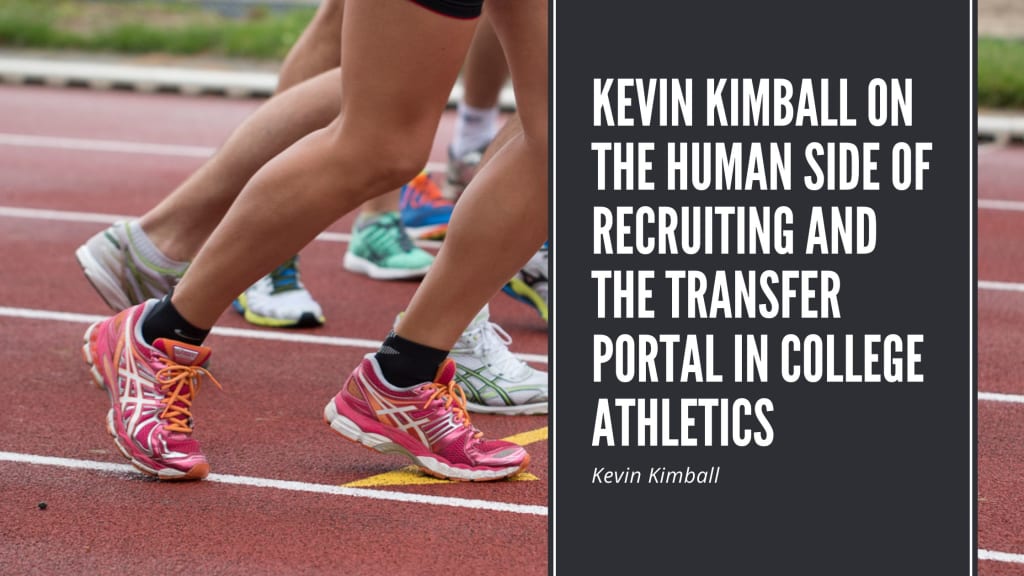Kevin Kimball on the Human Side of Recruiting and the Transfer Portal in College Athletics
Things you should know

The NCAA transfer portal has transformed the landscape of college athletics recruiting, offering athletes newfound freedom and agency. While this brings great opportunities, it also creates challenges for coaches constantly on the hunt for the next standout player and for parents trying to understand how to navigate this process that is far more involved than a bunch of numbers on a screen.
Consider the coaches. Recruiting used to be a multi-year process of building relationships with young athletes, their families, and their high school coaches. Now, coaches scramble to fill roster spots with players who might leave just as quickly as they arrive. This constant churn can be exhausting. Imagine investing time and energy into a young player, only to see them enter the portal a year later.
The pressure on recruits can be overwhelming. The transfer portal has everyone wondering if there's a better deal out there, making it hard to commit to any one program. High school athletes are bombarded with calls from coaches, adding to the stress of figuring out their entire future in a short span of time. These aren't just numbers on a recruitment chart; they're teenagers trying to juggle the demands of big-time sports and college life, now being expected to make major decisions about their futures.
The real story here is about the people involved. Coaches aren't just walking playbooks; they're mentors who support and guide their players, often becoming like second parents. Recruits are more than just athletes; they're young individuals facing significant life choices. While the transfer portal has introduced new challenges, it also provides an opportunity to remember and honor the human element at the heart of college sports.
Navigating this new landscape means balancing innovation with tradition. While the portal offers athletes more control, it's essential to maintain the relationships and emotional connections that define college athletics. Understanding this space requires recognizing both the opportunities and the pressures involved, ensuring that we stay true to the essence of what makes college sports so compelling.
So, how can this be done, and what should the parents of these players be looking for?
Honesty and Transparency: Coaches should openly share details about their program’s culture, playing time expectations, and academic support systems. It’s equally important for recruits and their families to understand these aspects and ask insightful questions to ensure alignment with their development goals and educational aspirations. Encouraging a positive dialogue helps kids and parents make informed decisions and fosters a supportive environment.
Building Relationships: The portal shouldn't replace the importance of genuine connections. Coaches should invest time in understanding recruits as people, not just stats on a page. Recruits should prioritize programs where they feel valued and supported, not just used to fill a gap.
Focus on Development: Rather than expecting the most from college students each and every game, we need to have a larger focus on overall development. Players who may be on the bench their first year could end up having great potential.
Of course, it is natural for coaches to want wins. But there should be a dedication to turning the kids into solid players and allowing them the opportunity to grow their skills. Sports shouldn’t be focused solely on winning but on developing your players so that they know how to handle the wins and the losses.
Programs should take a good look at their team and look for the potential in them. The best coaches look at the individual players, examine their strengths and weaknesses, and find that special quality that will benefit the team as a whole. I know that is the type of coach I’d want my daughter to have.
Finding the Right Fit: The portal can be a valuable tool but shouldn't be the sole factor. Both coaches and recruits need to ensure there's a cultural fit. A star athlete will only thrive in a program that aligns with their personality or playing style.
The transfer portal isn't going anywhere. However, by focusing on the human element, we can create a more balanced system that respects athletes' freedom and supports the parental role in this process while recognizing coaches' hard work and dedication. It's about building genuine connections, fostering development, and ultimately creating a more positive experience for everyone involved in college athletics.
About the Creator
Kevin Kimball
Kevin Kimball is a business owner and strategic advisor. He owns and operates Game On Travel and Game On Consulting. Visit KevinKimball.info for more info.
Enjoyed the story? Support the Creator.
Subscribe for free to receive all their stories in your feed. You could also pledge your support or give them a one-off tip, letting them know you appreciate their work.






Comments
There are no comments for this story
Be the first to respond and start the conversation.